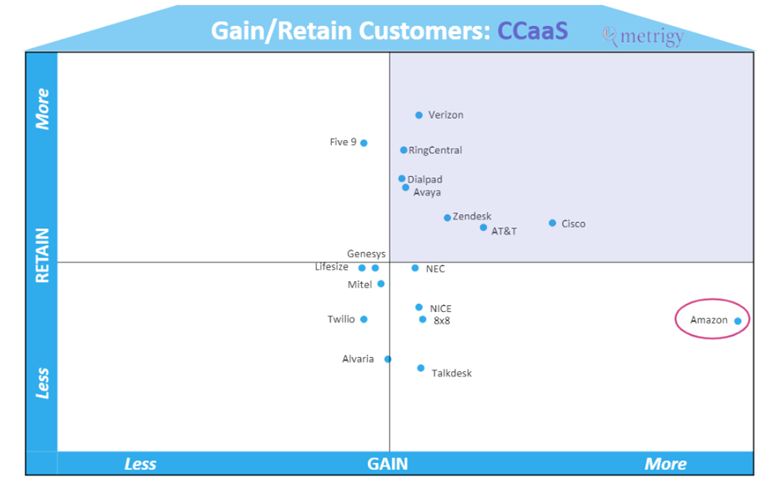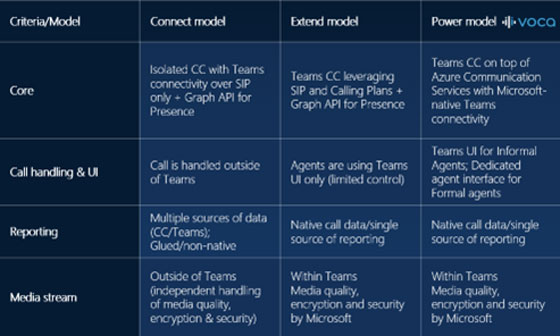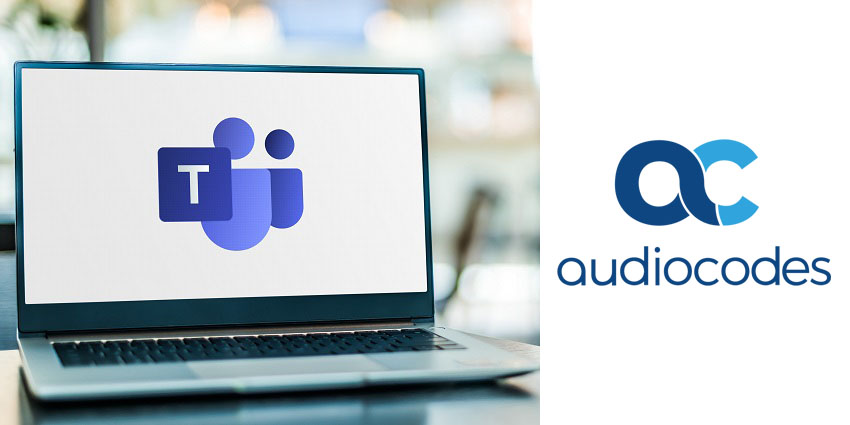Amazon leads the CCaaS market in customer acquisition, yet lags other prominent providers in customer retention.
Such is the conclusion of a 2022 Metrigy study entitled: “Contact Center Platform Gain/Retain,” which highlights this through the following chart.

Digging deeper, the research reveals that the top reason companies leave Amazon is that they want to use a single integrated platform for both unified communications and contact centres.
Why? First and foremost, companies look to leverage their investment around Teams migration for Contact Centre needs, efficiently tying UC and CC under one single technology infrastructure.
But moreover, it is not only traditional customer service agents that communicate with customers – especially in smaller businesses. IT, HR, finance, sales, marketing, and numerous other departments may also benefit from the telephony, alongside the knowledge management, IVR, routing, queuing, and automation tools available within modern CCaaS platforms.
However, these departments rarely have the resources to integrate traditional contact centre tools into their technology ecosystem. It is often considered overkill.
Thankfully, recent innovations that bring CCaaS capabilities into Microsoft Teams present an attractive alternative.
Why Microsoft Teams?
In 2021, Metrigy surveyed 395 companies, across 39 verticals, in 11 countries located in North America. 70 percent of those businesses used Teams.
The platform – therefore – offers a familiarity that many employees will likely enjoy.
Yet, the success of Teams is perhaps also testament to the feature-rich ecosystem Microsoft offers.
Making this point, Gidi Adlersberg, Director of Product Marketing & Business Development, at AudioCodes, says:
Microsoft has a strong foothold in AI with Azure Cognitive Service, in Collaboration services with Teams, and data collection/aggregation with Dynamics, which all function and interconnect within the very same ecosystem.
Indeed, such an ecosystem is potentially powerful when connected with Microsoft’s many other CX technologies, including its business intelligence, journey orchestration, and cognitive tools.
For this reason, more businesses are starting to look for CCaaS platforms that integrate with Teams, as they may already use – or plan to use – other technologies within the Microsoft stack.
A New Way to Merge Microsoft Teams with the Contact Centre
As previously noted, when businesses wish to empower users throughout the enterprise with CX technology, they once had to deploy an expensive, comprehensive CCaaS solution. Such a platform often proves too capable for what companies actually need.
For many, justifying such a cost was tricky. It just doesn’t make sense to purchase a premium CC platform for IT helpdesk, HR or other internal business lines. However, a UC tool – such as Microsoft Teams – does not cut the mustard on its own, failing to allow users across the business to communicate with customers effectively.
Enter the Voca Conversational Interaction Center. Plugging the gap, it provides much more than is natively available within Microsoft Teams.
No, it is not a Genesys, NICE, or Five9, but it is a “contact centre lite” that delivers the most critical components of a CCaaS solution, coupled with built-in conversational AI, all tightly integrated and leveraging Teams to its full extent.
Sharing more, Adlersberg states:
The idea is to leverage Microsoft Teams to provide a contact centre experience that does not go as far as a full CCaaS platform but offers exactly what the vast majority of customers are looking for.
How does it work? Well, there are three models for contact centre integrations with Teams: Connect, Extend, and Power. The table below showcases the central components of each.

Although Microsoft does not disclose the model of each CC vendor, according to AudioCodes, out of the ten certified Teams contact centres today, eight are “Connect” models and two are “Extend”. These models are described in detail on on Microsoft’s website. Currently, there are no “Power” model CCs officially certified.
The table highlights weaknesses within the Connect and Extend offerings. With Connect, the contact centre is isolated from Teams, routing calls to the UC platform via a SIP trunk. As such, the CCaaS vendor handles media quality, encryption and security. Meanwhile, reporting is non-native and arrives from multiple data sources.
“Extend” is much better, as companies can handle customer conversations entirely within Teams. However, agents work with the Teams user interface (UI), which lacks sophistication and rich agent controls typically required by Contact Centre users.
Now, there is “Power”. Soon to become generally available, it has each of the benefits of the Extend offering, plus the luxury for vendors to develop rich agent application on top of the Teams Voice infrastructure.
The following video explains the differences between each three models in greater detail:
In the upcoming months, AudioCodes expects Voca to officially become a Microsoft-certified Teams Contact Centre solution that harnesses the Power model.
How Will This Improve Service Experiences?
“A good caller experience starts with a happy agent,” says Adlersberg. “When you make their lives easier, they will automatically provide better customer service.”
Through leveraging the Microsoft Power model to develop a Teams contact centre, companies can create unified experiences for agents – from a single, effective interface – that paves the way for better service experiences and efficiency in leveraging the great resource investment already made around Teams Voice migration.
Indeed, operations may unlock several newfound benefits, including:
- Bi-directional Presence-based routing logic
- Seamless connections to subject matter experts throughout the enterprise
- Knowledge sharing features to spread customer insights across the business
- New tools for departments, other than the contact centre, to connect with customers
Moreover, the Voca platform can supplement AI transformation. It embeds Microsoft Cognitive Services, making it effortless for departments – other than the contact centre alone – to consume and leverage conversational AI.
Discussing the AudioCodes approach to conversational AI, Adlersberg adds:
Most vendors allow customers to bring conversational AI into their call flows, but the customer needs to customize, integrate and pay for the cognitive services – such as Speech-to-text, Natural Language Understanding and Text-to-speech – separately. With Voca, everything is built-in and ready to work within any automated call flow, not only technically, but also commercially.
Indeed, AudioCodes includes Microsoft Cognitive Services in its pricing, allowing companies with little to no conversational AI expertise to use the technology and create quicker, slicker customer experiences.
As a result, companies can harness agent support, knowledge management, collaboration, automation, and telephony tools from Teams, to facilitate enhanced customer, employee, and business outcomes.
Ready to migrate to a Microsoft Teams contact centre? AudioCodes is here to help. Discover more by visiting its website.







